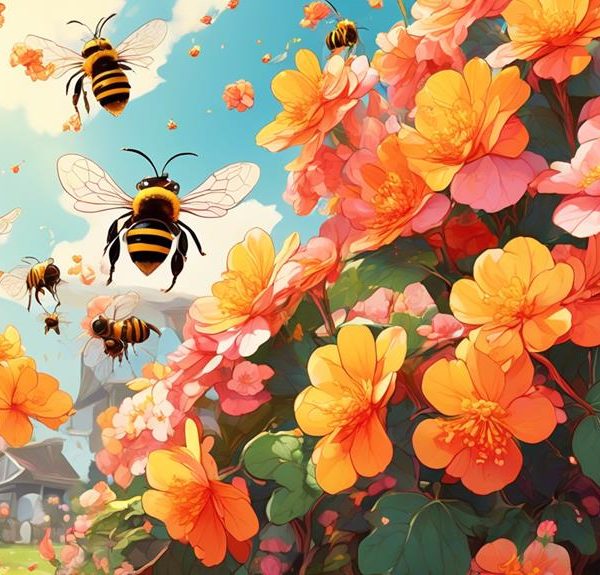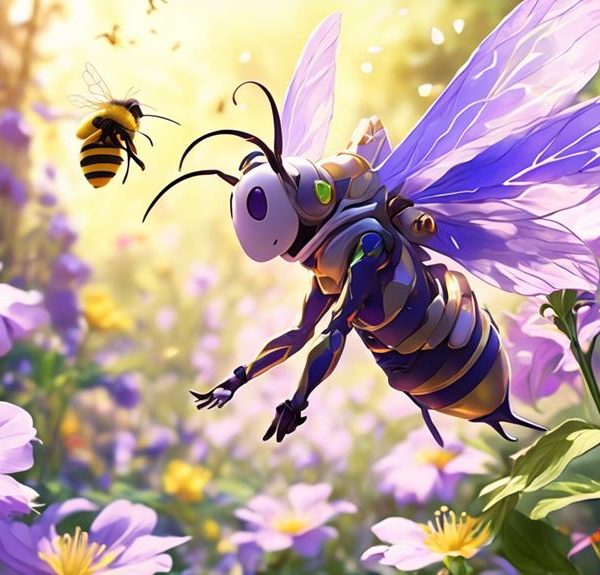Kneading through the mystery, we unravel whether bees appreciate the human touch or view it as a threat – prepare for a surprising discovery!
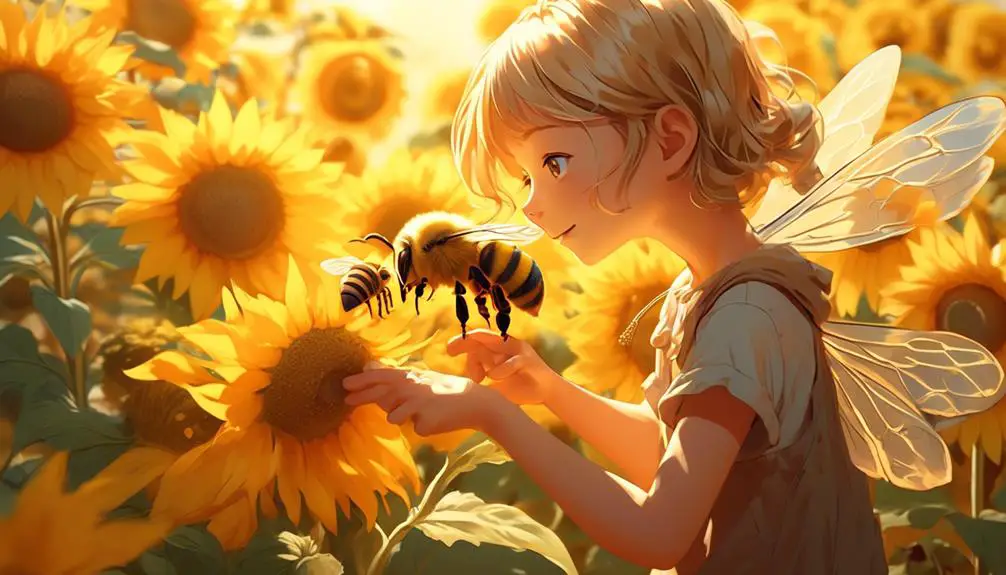
Do Bees Like Being Pet
In the bustling world of the bee, you may wonder if the hum of human touch is welcomed or a cause for alarm. As a nature enthusiast, you're no stranger to the intriguing behaviors of creatures big and small, yet the concept of petting bees might still surprise you. Is it a display of trust between species or a dangerous misunderstanding of bee communication?
This unusual question might be more complex than you'd expect, with answers rooted in both the biology of bees and the nature of human curiosity. So, let's consider the evidence and unravel the mystery, shall we?
Key Takeaways
- Bees communicate through movements, vibrations, touch, and smell, but physical contact is perceived as a potential threat.
- Bees can become accustomed to human touch with time and handling, but touching bees can stress them and lead to aggressive responses.
- Bee stings are fatal for the bee, and damaging bee hairs can impact their role in the hive and ecosystem.
- Observing bees from a safe distance without disturbing them is the best way to observe them safely and avoid being stung.
Understanding Bee Behavior
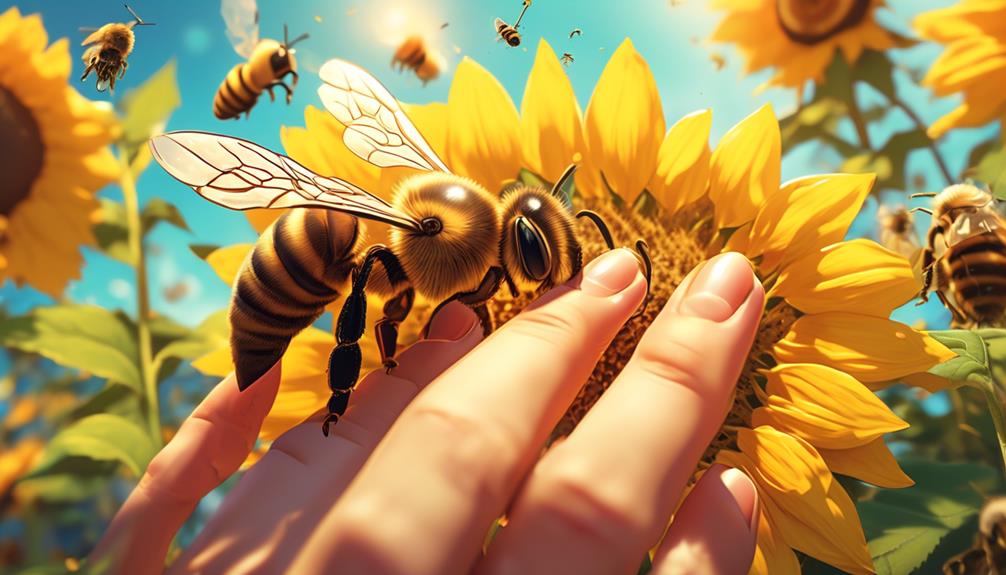
To truly grasp why bees may or may not enjoy being pet, you'll need to delve into the fascinating world of bee behavior, where every buzz, waggle, and flight pattern holds a story. Bees communicate through a complex system of movements and vibrations, each one carrying a specific message. The famous 'waggle dance', for instance, is a bee's way of directing its hive mates to a food source.
Understanding bees' reactions to touch is a bit more complicated. You see, bees don't have a nervous system like ours. They don't 'feel' in the way we do. Instead, any physical contact is likely to be perceived as a potential threat, triggering an instinctive defensive response. This is why you're more likely to get stung than receive a bee's affectionate nuzzle.
However, bees are extraordinarily adaptable creatures. With time and careful handling, it's possible that a bee could become accustomed to your touch. But remember, this isn't a pet dog we're talking about – it's a wild creature with its own rules and instincts. So, while the idea of petting bees is charming, it's best to leave these remarkable insects to their own devices.
The Science Behind Bee Communication
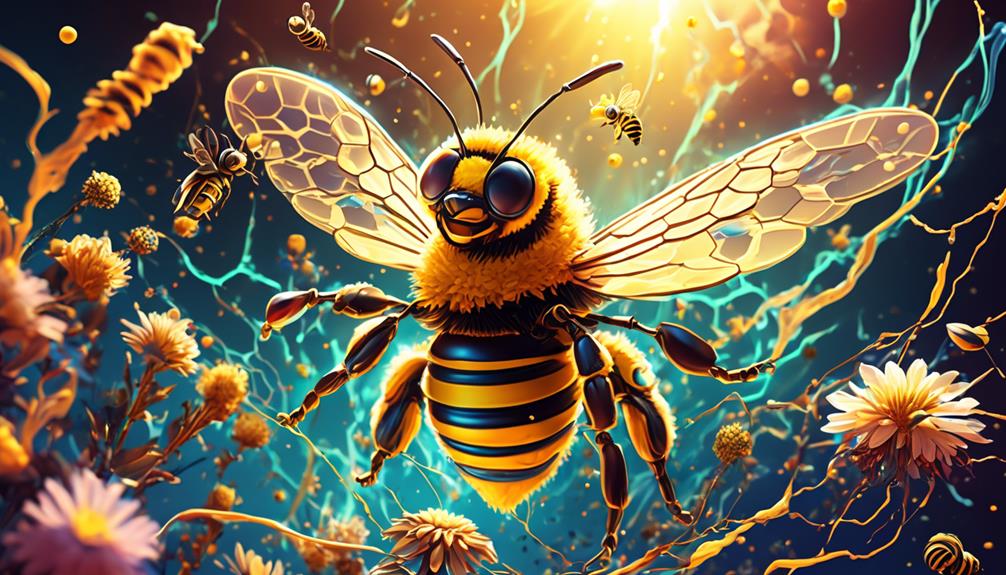
Delving deeper into the art of bee communication, you'll discover a world that's nothing short of extraordinary, where tiny insects convey complex messages through intricate dances and vibrations. You'll find that bees aren't just mindless drones, but rather, sophisticated creatures with a unique language of their own.
Known as the 'waggle dance', worker bees perform this fascinating ritual to share the location of food sources with their hive mates. When a bee finds a good food source, it'll return to the hive and perform a figure-eight dance. The angle of the dance indicates the direction of the food, while the duration of the waggle part of the dance indicates the distance.
Bees also communicate through touch and smell. They secrete pheromones to signal a variety of messages, like warning of danger, attracting mates, or marking territory. A queen bee, for instance, emits a special pheromone that keeps the worker bees sterile.
Understanding this complex communication system is crucial for beekeepers and scientists alike. It's not just about knowing if bees like being pet, but rather, about appreciating the intricate language that these tiny creatures have developed over millions of years.
Bees and Human Interaction
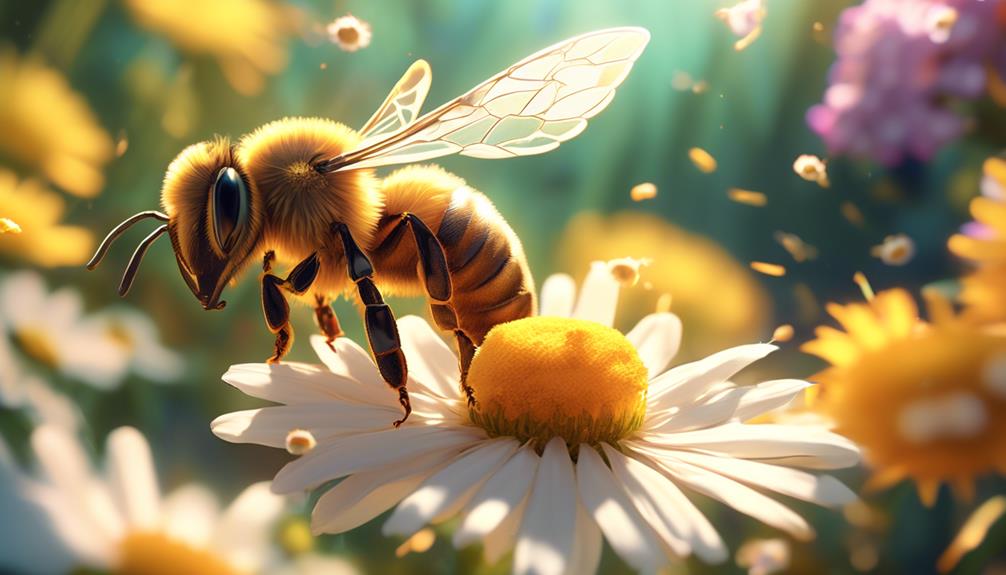
Over the ages, you might wonder how bees have interacted with humans, a relationship that's both intriguing and complex, full of mutual benefits and potential dangers. It's a dance as old as time, with humans reaping the rewards of honey and pollination, while navigating the risk of stings.
Bees don't just buzz around aimlessly, they're critical for human survival, pollinating plants that make up a large part of our diet. Imagine a world without fruits, nuts, and vegetables, that's a world without bees. But they're not just working for us, they're working for the entire ecosystem, maintaining biodiversity and the survival of countless species.
Human Actions | Bee Responses |
|---|---|
Planting | Pollination |
Honey Collection | Hive Defense |
Pest Control | Colony Collapse |
Habitat Destruction | Population Decline |
Education & Conservation | Survival & Flourishing |
However, our actions can also harm bees. Pesticides, habitat destruction, and climate change are causing bee populations to decline. That's why it's crucial to understand them, respect them, and advocate for their protection. So, while you shouldn't necessarily pet bees, you can definitely play your part in their survival. Bees are incredible creatures, and we are forever intertwined in this dance of coexistence.
Risks of Petting Bees
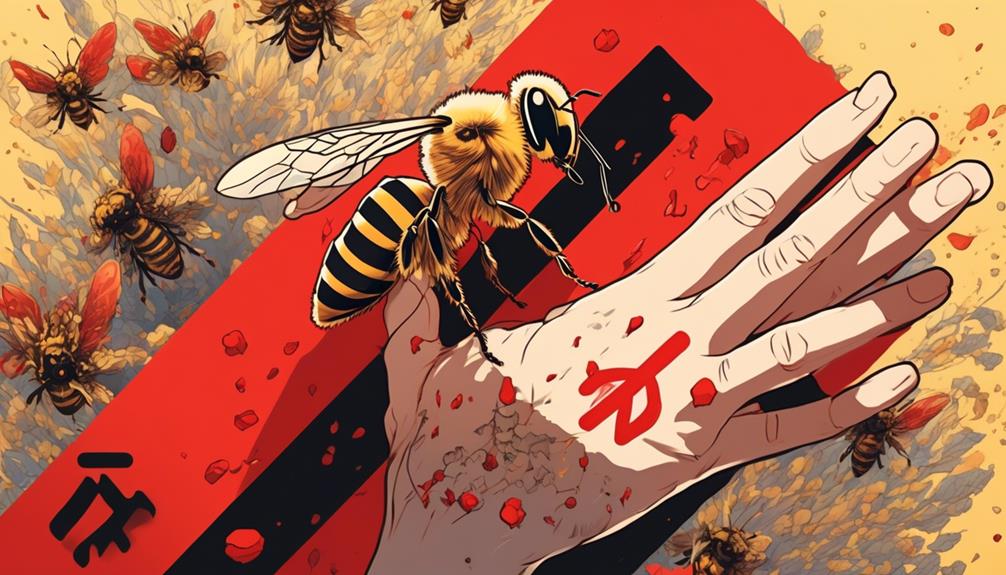
While it may seem like a quirky, harmless notion, petting bees actually carries significant risks both for you and the bee. Bees aren't domesticated creatures, they're wild insects with their own instincts and behaviors. Your touch can stress them out, leading to aggressive responses that can result in painful stings.
Remember, when a bee stings, it's not just a minor inconvenience for you; it's a death sentence for the bee. Bees aren't equipped to withstand the physical trauma of their stinger being ripped from their bodies. By petting a bee, you're increasing the likelihood of this tragic outcome.
Besides, bees are covered in a delicate layer of hairs that can be easily damaged by the oils and pressure from human touch. These hairs are vital for pollen collection, which in turn is crucial for the survival of both the bee and its hive. Damaging these hairs can significantly impact a bee's ability to perform its role in the hive and in our ecosystem.
Observing Bees Safely
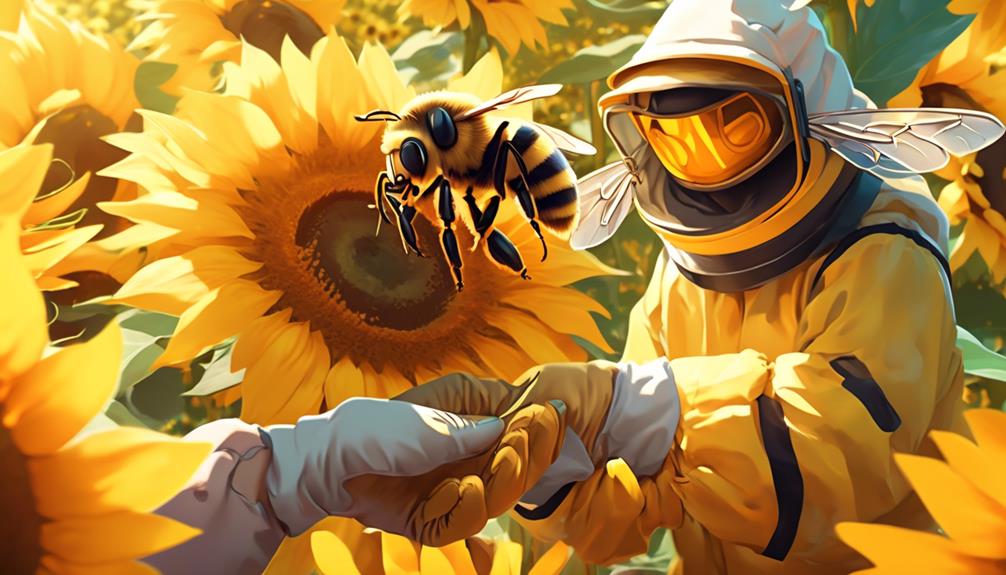
You can marvel at the intricate world of bees and their fascinating behaviors without risking their well-being or your own, simply by observing them from a safe distance. There's no need to interfere with their daily routines or invade their space to appreciate their significance in the ecosystem.
Firstly, find a spot that allows you to watch the bees without disturbing them. Bees are particularly active during sunny days, so that's the best time to observe them. Don't wear bright colors or floral prints, as bees might mistake you for a flower. Also, avoid wearing perfumes as they can attract bees.
If you're observing a bee hive, stay at least 5 meters away to ensure you're out of their flight path. Don't make any sudden movements; be as calm and still as possible. Bees usually only sting when they feel threatened, so if you respect their space, you'll be safe.
Lastly, remember that bees are protected species in many places and it's illegal to harm them. Observing bees requires patience, but it's a rewarding experience that allows you to better understand these hardworking, incredible creatures.
Promoting Bee Conservation Efforts
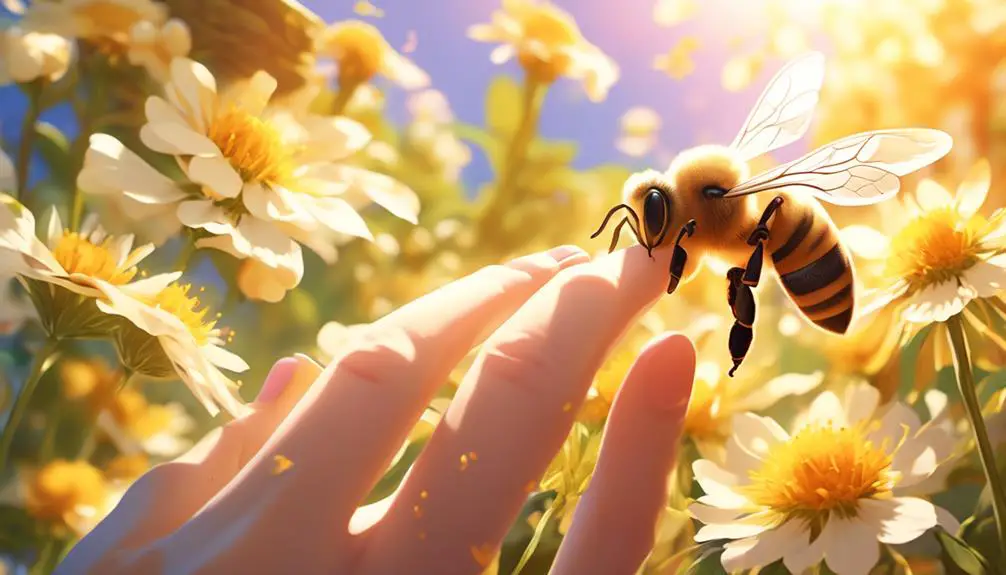
Let's dive into the critical role we all can play in promoting bee conservation efforts, a task that's not just beneficial, but vital for our ecosystem's balance. You see, bees are the world's most important pollinators of food crops, with an estimated third of the food we consume daily relying on pollination mainly by bees. Yet, they're more endangered than ever, threatened by habitat loss, climate change, pesticides, and disease.
So, how can you help? It's easier than you think. Start by planting a bee-friendly garden. Include native plants that bees love, and consider letting your lawn grow wild. Bees thrive in diverse habitats, so the more varieties of plants, the better. Avoid using pesticides, as they're harmful to bees. Instead, opt for organic methods to keep pests at bay.
Support local beekeepers by purchasing their honey or beeswax products. This not only helps sustain their important work but also contributes to local economies. You can also sponsor a hive or even start your own if you've got the space and the inclination.
Ultimately, we're in this together. Each step you take counts in this vital mission to save our precious pollinators. Be a part of the solution. Stand up for bees.
Frequently Asked Questions
What Are Some Common Misconceptions About Bees?
You might believe bees are aggressive, but that's a common misconception. They're actually quite docile unless provoked.
Another myth is that all bees produce honey, but only honey bees do.
You might also think bees die after stinging, but this only applies to honey bees.
Lastly, many believe bees are a nuisance, but they're crucial for pollination and biodiversity.
It's important to understand their role and dispel these misconceptions.
How Does Climate Change Impact Bee Populations?
Climate change drastically impacts bee populations. Warmer temperatures can disrupt the synchronization between bees and flowering plants. When flowers bloom earlier due to higher temperatures, bees may miss out on vital food sources. Increased frequency of extreme weather events can destroy bee habitats. So, you see, climate change doesn't just affect us, it's a big deal for bees too.
Can Bees Recognize Individual Human Faces?
You'd be amazed to know that bees, despite their tiny brains, can recognize human faces! They're not just buzzing around aimlessly, they're actually quite intelligent.
Bees use complex visual recognition and memory to identify and remember individual faces, much like you'd remember a friend's face. It's a fascinating aspect of their behavior that's still being explored.
What Are Some Other Insects That Are Commonly Mistaken for Bees?
You might often confuse other insects for bees due to their similar appearance.
For instance, yellow jackets, a type of wasp, are frequently mistaken for bees. Their black and yellow stripes make them look quite similar.
Hoverflies are another insect that can fool you. They mimic bees' coloring to ward off predators.
Carpenter bees can also be misleading, as they're large and robust like bumblebees.
Don't be fooled, though. Not every buzzing creature is a bee.
How Can Homeowners Create a Bee-Friendly Environment in Their Garden?
Creating a bee-friendly garden isn't rocket science. You've got to plant a variety of flowers that bloom throughout the year. Bees love lavender, sunflowers, and rosemary. They're attracted to bright colors.
Don't forget a little water source—it can be a bird bath or shallow dish. Ditch the pesticides, they're harmful to bees. Let some of your garden grow wild—bees enjoy undisturbed spaces.
You're not only helping bees, but your garden will thrive too.
Conclusion
So, do bees like being pet? Sadly, no. They're not like dogs or cats. They communicate differently and perceive the world in ways we're still learning.
Petting can harm them, and risks you getting stung. Yet, they're fascinating to observe from a distance, and crucial for our ecosystem.
Let's respect their space and focus on conservation efforts to ensure they keep buzzing and pollinating, making our world a blooming, thriving place.

